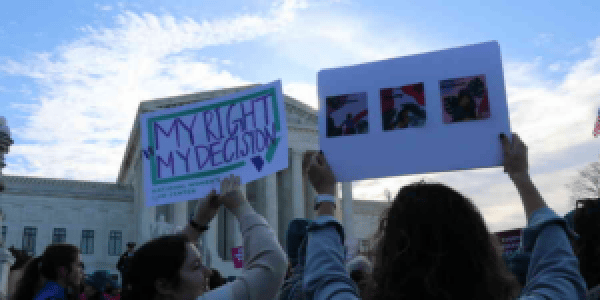Abortion rights, women of color, and LGBTQI+ people are under attack. Pledge to join us in fighting for gender justice.
Male Victims of Richard Strauss at OSU Deserve to Have Their Title IX Claims Heard in Court
*** Victory! Update! *** On September 14, 2022, the Sixth Circuit held that the Ohio State University male students, including student-athletes, adequately alleged that they did not know and could not reasonably have known that OSU had injured them until 2018, when OSU announced it was hiring a firm to investigate Dr. Richard Strauss for alleged sexual abuse. In support of its decision, the Sixth Circuit cited NWLC’s amicus brief, which explained that “recognizing abuse—especially physician-patient abuse—can be even harder in the context of college athletics because of the insular nature of teams, the immense trust and authority placed in coaches, and the culture of college athletics, including the role of coaches and trainers in setting norms.” We are so glad that the plaintiffs will be allowed to continue their lawsuits!
***
On February 9, 2022, the National Women’s Law Center and Women’s Sports Foundation, alongside our law firm partner Weil, Gotshal & Manges LLP, filed motions to submit amicus briefs to the Sixth Circuit in Moxley v. Ohio State University and Snyder-Hill v. Ohio State University, bringing along 49 additional advocacy organizations, in support of 118 former Ohio State University (OSU) male students, including student-athletes, who were sexually abused by Dr. Richard Strauss from 1978 to 1998. Our brief focuses on the unique vulnerabilities faced by athletes that prevent them from recognizing that they have been sexually abused.
For 20 years, as an official team doctor for OSU sports and a doctor at the student health center, Strauss performed hundreds of invasive and medically unnecessary examinations of male student-athletes’ and other male students’ private body parts—even if they had unrelated medical issues, like an arm or ankle injury or a sore throat. When questioned about his exams, Strauss gave his patients so-called “clinical explanations” for why they were supposedly necessary. When athletes raised concerns with coaches and staff, they were ignored and dismissed. OSU staff also made “jokes” about the mistreatment that served to undermine how students were being abused. As a result, Strauss’s victims did not understand that what they experienced was sexual abuse.
It was not until April 2018, after Dr. Larry Nassar had been convicted of similar sexual abuse at Michigan State University, that OSU announced it would hire outside investigators to look into Strauss’s abuse. After sifting through 825 boxes of evidence and interviewing 520 witnesses over 12 months, the investigators concluded that at least 50 OSU athletics trainers, coaches, and directors knew about Strauss’s abuse, some as early as 1979. Yet OSU concealed the abuse for 40 years. It lied to students, including by denying there had been prior complaints against Strauss and destroying his victims’ medical records. Additionally, OSU gave Strauss exceptional reviews, repeatedly promoted him, and let him retire in 1998 with emeritus status—even after internally admitting to his abuse.
As with many survivors, most of the victims in these cases did not understand that they had been sexually abused and that OSU was responsible for not addressing and preventing this abuse. It was not until 2018—when OSU announced its investigation and when Nassar was convicted—that they realized Strauss had sexually abused them. Despite this reality, a district court in Ohio dismissed their Title IX claims as untimely, ruling they should have sued OSU within 2 years of the abuse or of their last day at OSU. Moreover, the court said that Strauss’s victims should have investigated back in the 1970s-1990s to find out whether OSU knew about the abuse and covered it up. This decision is absolutely harmful, will limit access to justice for many survivors, and must be reversed.
Our amicus brief explains that sexual assault is widely prevalent, especially on college campuses, and that survivors commonly fail to recognize sexual abuse. College athletes are especially vulnerable to being subjected to sexual abuse and to failing to recognize it as such. Because they spend as many as 40-50 hours per week with their teammates and coaches, college athletes often develop an intense love and trust for their team and school. In addition, college athletes are trained to defer to their coaches’ and doctors’ authority, creating an almost unquestioning level of trust that can make it difficult to recognize abuse, particularly when they are also dependent on their schools for scholarships. Furthermore, there is a culture of “toughness” in college sports—and “manliness” in men’s sports—that encourages minimization and normalization of discomfort, particularly with male survivors. Given these dynamics, it is unsurprising that many of Strauss’s victims believed his exams were legitimate—and just an uncomfortable “rite of passage”—rather than sexual abuse. After all, they trusted their coaches and school would not have required them to undergo those exams unless they served a legitimate medical purpose.
The district court was wrong to blame student-athletes—and cut off their access to justice—for not knowing what a team of professional investigators needed 12 months and $6.2 million to find out: that Strauss sexually abused hundreds of survivors and OSU covered up the serial abuse for 40 years. If this harmful legal decision is not reversed, it will encourage schools to conceal sexual abuse for as long as possible in order to try to escape legal liability, making more and more students vulnerable to sexual abuse.





